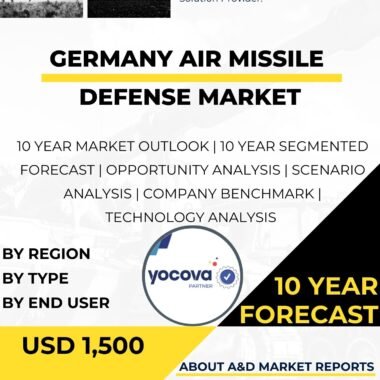Description
South Korea AESA Radar Market
In recent years, South Korea has made remarkable strides in the development and deployment of cutting-edge radar technologies, with Active Electronically Scanned Array (AESA) radars playing a pivotal role in its defense modernization efforts. AESA radars offer significant advantages over conventional radar systems, including enhanced target detection, tracking capabilities, and electronic warfare resistance. This article provides a comprehensive analysis of the South Korea AESA Radar market, covering its current state, major players, technological advancements, applications, challenges, and future growth prospects.
The South Korean AESA Radar market has seen substantial growth as the country aims to bolster its defense capabilities in response to regional security challenges. South Korea’s advanced defense industry and strong research and development (R&D) capabilities have contributed to the successful domestic development of AESA radars. The country’s Ministry of National Defense has been actively promoting indigenous defense technologies, leading to the incorporation of AESA radars into various military platforms, including fighter aircraft, naval vessels, and ground-based systems.
Several major South Korean defense companies have been at the forefront of developing and manufacturing AESA radars. One of the key players is Hanwha Systems, a leading defense contractor that has made significant strides in the development of AESA radar technology. Their radar systems are widely used in South Korea’s fighter jets, such as the KAI KF-21 Boramae, enhancing the aircraft’s multi-role capabilities and situational awareness.
LIG Nex1, another prominent South Korean defense company, has also been actively involved in AESA radar development. Their AESA radar solutions are integrated into various naval vessels and ground-based air defense systems, providing reliable and advanced target tracking and surveillance capabilities.
Additionally, the state-owned Agency for Defense Development (ADD) has played a critical role in indigenous AESA radar research. Collaborating with local defense industries, the ADD aims to further enhance South Korea’s self-reliance in radar technology and strengthen the country’s defense capabilities.
Technological advancements have been instrumental in driving the growth and capabilities of South Korean AESA radars. AESA technology allows radar beams to be electronically steered, enabling faster scanning, agile beam pointing, and enhanced tracking accuracy. These features make AESA radars highly effective in detecting and engaging multiple targets simultaneously, improving overall situational awareness and mission success rates.
South Korean defense companies have also made strides in developing GaN (Gallium Nitride) technology, which offers higher power output, improved efficiency, and greater reliability compared to traditional GaAs (Gallium Arsenide) technology. GaN-based AESA radars provide higher performance while reducing the radar’s size, weight, and power consumption, making them ideal for integration into various platforms.
Furthermore, the integration of AESA radars with advanced data processing and fusion capabilities has further expanded their functionalities. Modern AESA radars can employ advanced signal processing algorithms and machine learning techniques to identify and mitigate electronic warfare threats effectively.
AESA radars find a wide range of applications across various domains, including military aviation, naval operations, and ground-based air defense. In the military aviation sector, AESA radars are widely integrated into fighter aircraft, providing pilots with a clear and comprehensive picture of the battlespace. The ability to track multiple targets simultaneously and execute electronic attacks enhances the aircraft’s combat capabilities and survivability.
In the naval domain, AESA radars are deployed on naval vessels, such as frigates and destroyers, to provide long-range surveillance, target tracking, and anti-aircraft warfare capabilities. Their ability to detect low radar cross-section targets and execute electronic countermeasures contributes to the vessel’s situational awareness and self-defense capabilities.
On the ground, AESA radars are used in air defense systems to detect and track airborne threats, such as enemy aircraft, missiles, and drones. These radars play a crucial role in protecting critical assets and military installations from aerial threats.
Despite the advancements, the South Korean AESA Radar market faces several challenges. One of the primary challenges is the high cost associated with AESA radar technology, which may limit its widespread adoption across various defense platforms. However, ongoing research and development efforts are expected to drive down costs over time.
Another challenge is the increasing sophistication of electronic warfare and counter-radar technologies. Adversaries are continuously developing methods to degrade or defeat AESA radars, necessitating ongoing investments in radar electronic protection and countermeasures.
Looking ahead, the future growth prospects for the South Korean AESA Radar market remain positive. The country’s commitment to advancing indigenous defense technologies, coupled with collaborations with international defense players, is expected to foster further innovation and growth in the AESA radar sector. The demand for AESA radars in international markets presents export opportunities for South Korean defense companies, strengthening their global presence and fostering economic growth.
The South Korean AESA Radar market has experienced substantial growth, driven by the country’s efforts to enhance its defense capabilities and address regional security challenges. Indigenous developments by major defense companies, research initiatives by the Agency for Defense Development, and technological advancements in AESA radar technology have propelled South Korea to become a significant player in the global radar market. Challenges, such as high costs and electronic warfare threats, continue to be addressed through ongoing research and development efforts. The future prospects for the South Korean AESA Radar market remain promising, with potential export opportunities and further contributions to global radar technology advancements. As South Korea continues to innovate and invest in its defense sector, AESA radars will continue to play a crucial role in enhancing the country’s national security and strengthening its position as a technologically advanced defense player on the international stage.




